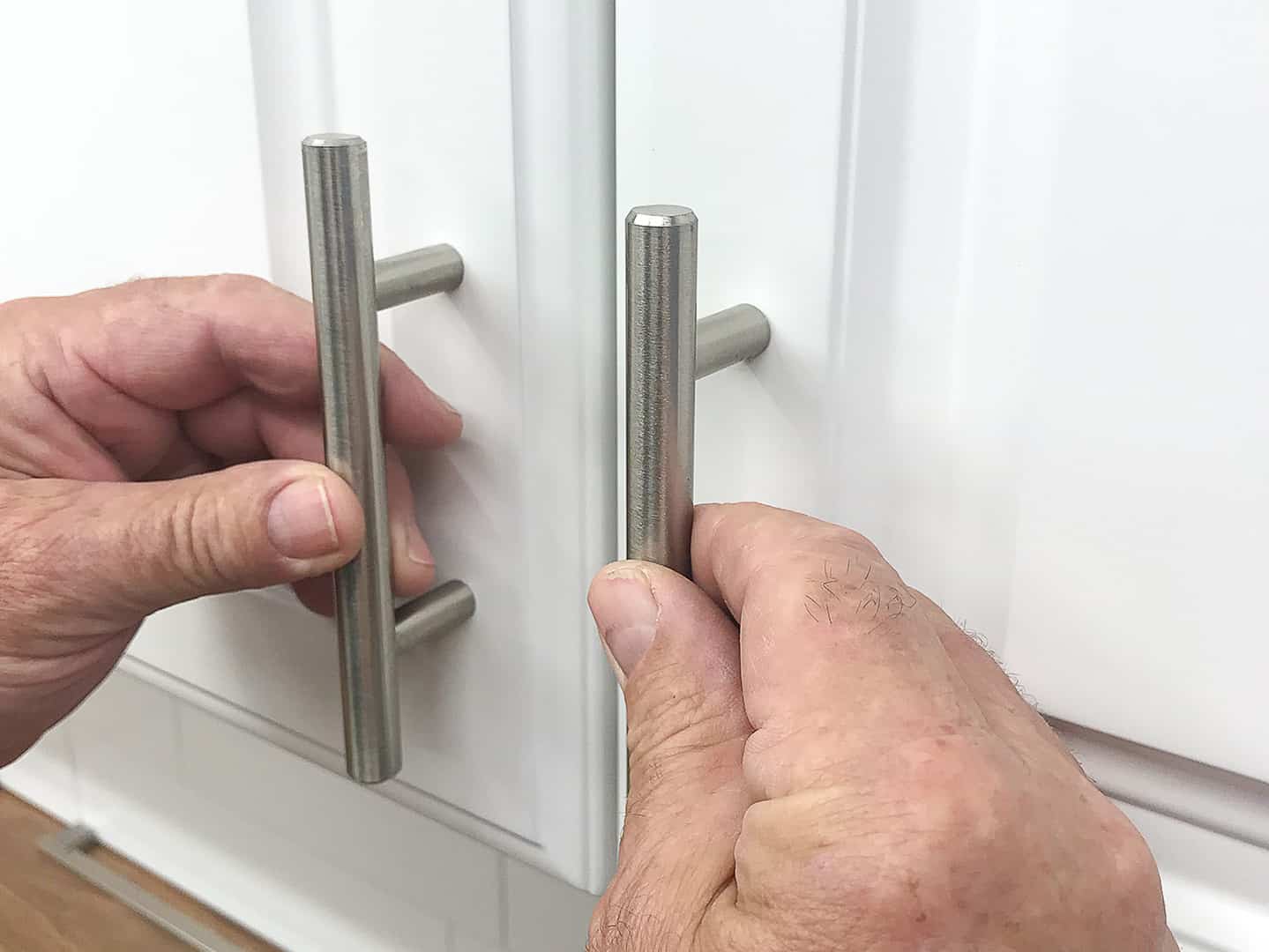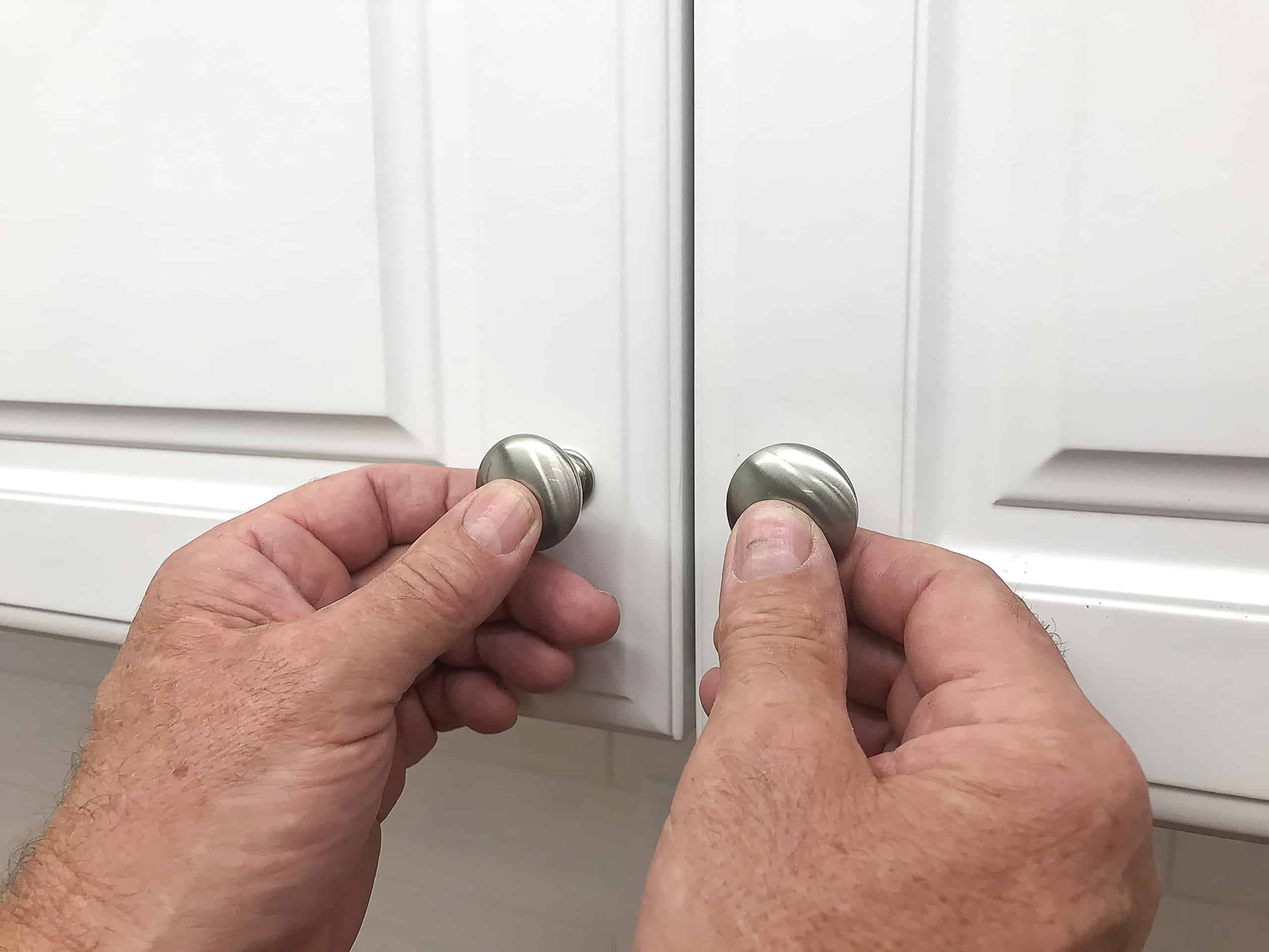Understanding Cabinet Door Types and Hinges

Choosing the right hinges for your cabinet doors is crucial for both aesthetics and functionality. The type of door and the hinge will work together to create a smooth, reliable, and visually appealing result. Understanding the interplay between these two elements is key to a successful installation.
Cabinet Door Types
Cabinet doors are categorized primarily by how they overlay the cabinet frame. This significantly impacts hinge placement and installation.
How to attach a cabinet door – Overlay Doors: These doors extend slightly over the cabinet face, typically by 1/8″ to 1/2″. This creates a clean, modern look. Hinges are typically placed on the inside of the door, slightly recessed. Imagine a partially overlapping door with hinges hidden within the frame’s shadow.
Full Overlay Doors: These doors completely cover the cabinet face, hiding the frame entirely. This style offers a sleek, minimalist aesthetic. The hinges are often concealed, completely hidden from view, and are usually mounted further out on the door. Picture a seamless, uninterrupted cabinet front with no visible frame.
Inset Doors: These doors sit within the cabinet frame, creating a more traditional and often more expensive look. Hinges are typically surface-mounted on the door, though sometimes partially recessed. The door sits completely flush with the frame, creating a distinct border.
Hinge Types and Suitability
Several hinge types cater to different door styles and installation preferences. Choosing the correct hinge is vital for both ease of installation and long-term performance.
| Hinge Type | Description | Installation Difficulty | Cost |
|---|---|---|---|
| Full Mortise Hinge | Traditional hinge with leaves that are completely mortised (inset) into the door and cabinet. Provides excellent strength and durability. | High (requires precise mortising) | Moderate to High |
| Half Overlay Hinge | One leaf is mortised into the door, the other is surface mounted on the cabinet. Suitable for overlay doors. | Medium | Moderate |
| Concealed Hinge (European Hinge) | Hinges are completely hidden when the door is closed. Popular for full overlay and some inset doors. | Medium to High (precise placement is crucial) | Moderate to High |
| Self-Closing Hinge | Features a mechanism that automatically closes the door. Available in various styles and can be combined with other hinge types. | Medium (depending on hinge type) | High |
Identifying Existing Hinges
Before replacing or adding hinges, correctly identifying the type already installed is crucial for selecting compatible replacements.
Begin by carefully examining the hinge. Note the placement of the hinge on the door and cabinet. Is it fully recessed, partially recessed, or surface mounted? This immediately narrows down the possibilities. Next, look at the hinge’s construction. Does it have visible screws on the face, or is it completely hidden? Does it have a self-closing mechanism? Counting the number of hinge leaves can also be helpful. Finally, if possible, check the hinge’s markings for a manufacturer’s name or model number, which can be used to find compatible replacements online.
Tools and Materials Needed for Installation

Successfully installing a cabinet door hinges on having the right tools and materials at your fingertips. A well-organized workspace and the correct equipment will ensure a smooth, efficient, and accurate installation, preventing frustration and potential damage. This section Artikels the essential items needed for a professional-looking finish.
Preparing your workspace and gathering your tools beforehand will significantly reduce installation time and improve accuracy. Having everything readily accessible minimizes interruptions and allows for a focused approach to the task. This methodical approach translates to a higher quality installation and a more satisfying result.
Essential Tools
A well-equipped toolbox is crucial for this project. The following list details the specific tools you’ll need, ensuring a smooth and accurate installation. Don’t underestimate the impact of the right tools on the final result; they’re the key to precision and efficiency.
- Screwdriver(s): A Phillips head screwdriver (size #2 or #3) is essential for most hinge screws. A flathead screwdriver might be needed depending on the type of hinges and screws used. Consider having both a standard screwdriver and a magnetic tip screwdriver for easier screw handling.
- Drill with Drill Bits: A cordless drill will significantly speed up the process. You’ll need pilot drill bits slightly smaller than the screw diameter to pre-drill holes, preventing wood splitting. The size of the drill bit will depend on the screw size (usually between 1/16″ and 1/8″).
- Measuring Tape: Accurate measurements are critical for proper hinge placement. A standard 25-foot tape measure will suffice.
- Pencil: Use a pencil to mark hinge positions and other critical points on the cabinet door and frame. A mechanical pencil is ideal for precise markings.
- Level: A small, 6-inch level ensures that the cabinet door hangs perfectly straight and plumb. A level prevents the door from tilting or sagging.
- Safety Glasses: Always protect your eyes from flying debris by wearing safety glasses during drilling and screwing.
- Optional: A countersinking bit can create a flush finish for the screw heads, giving a more polished look. A magnetic parts tray can help keep screws organized.
Appropriate Screws for Cabinet Materials and Hinges
Selecting the right screws is critical for a secure and long-lasting installation. The screw type should match both the material of your cabinet and the type of hinges you are using. Using incorrect screws can lead to stripped holes, loose hinges, and even damage to the cabinet.
- Wood Screws: These are the most common type for attaching hinges to wooden cabinets. Choose a length appropriate for the thickness of the door and cabinet frame. The screw diameter should be slightly smaller than the pilot hole.
- Cabinet Screws: These are specifically designed for cabinet work, often featuring a sharper point and a finer thread for easier driving and greater holding power in wood. They are usually available in various lengths and finishes.
- Self-Tapping Screws: These screws create their own threads as they are driven in, which is useful for materials other than wood. However, they are generally not recommended for wooden cabinets, as they can strip the wood more easily than wood screws.
- Hinge-Specific Screws: Some hinge manufacturers supply their own screws, which are often specifically designed to work optimally with their hinges. Using these screws is generally recommended for the best results.
Ideal Workspace Setup, How to attach a cabinet door
A well-organized workspace is essential for a smooth installation. Consider these elements for optimal efficiency and accuracy. A poorly lit or cluttered workspace can lead to mistakes and frustration.
Imagine a well-lit area, such as a workbench or a clean kitchen counter, free from clutter. Your tools should be laid out within easy reach. The cabinet door and cabinet should be positioned firmly and stably on the work surface to prevent accidental movement during installation. Adequate lighting from above is crucial for precise marking and screw placement. This prevents shadows and ensures accurate work. The diagram below depicts this ideal setup.
Step-by-Step Installation Process for Different Hinge Types: How To Attach A Cabinet Door

Installing cabinet doors might seem daunting, but with the right approach and tools, it’s a manageable DIY project. This section details the process for different hinge types, ensuring a smooth and professional-looking finish. Remember to always double-check your measurements before drilling or screwing.
Concealed Hinge Installation
Concealed hinges offer a clean, modern aesthetic. Their installation requires precision, but the result is worth the effort. The process involves marking hinge locations, drilling pilot holes, and carefully attaching the hinges to both the door and cabinet.
First, position the door against the cabinet face, ensuring proper alignment and desired gap. Carefully mark the hinge cup locations on both the door and the cabinet frame. This typically involves using a hinge template, which provides accurate placement of the hinge cups. A clear image would show the template pressed against the door and cabinet, with pencil markings indicating the hinge locations. Next, using a drill with a Forstner bit (a bit designed for creating flat-bottomed holes), carefully drill the holes at the marked locations. A picture here would depict the precise drilling action, emphasizing the use of the Forstner bit to create clean, even holes. Ensure that the holes are deep enough to fully accommodate the hinge cups. Then, carefully insert the hinge cups into the drilled holes, ensuring a snug fit. A photograph would illustrate the hinge cups being inserted, highlighting their precise fit within the drilled holes. Finally, attach the hinges to the door and cabinet frame using appropriate screws. The image would show the completed hinge installation, emphasizing the flush fit of the hinges and the even spacing between the door and cabinet.
Full Mortise Hinge Installation
Full mortise hinges, while more traditional, provide exceptional strength and durability. Their installation requires more precision and involves creating mortises (recessed slots) in both the door and cabinet.
The process for installing full mortise hinges is more involved than for concealed hinges. It requires careful mortising of both the door and the cabinet to receive the hinge leaves.
- First, mark the hinge locations on both the door and cabinet, ensuring proper alignment. A picture would show the markings on the door and cabinet, highlighting the precise positioning of the hinges.
- Using a chisel and mallet, carefully create the mortises (recessed slots) to accommodate the hinge leaves. An image would showcase the precise chiseling technique, emphasizing the creation of clean, accurately sized mortises.
- Once the mortises are complete, carefully insert the hinge leaves into the mortises, ensuring a snug fit. A picture would illustrate the insertion of the hinge leaves into their respective mortises.
- Finally, secure the hinges using appropriate screws. An image would depict the completed hinge installation, showcasing the secure fit of the hinges and the flush alignment of the door and cabinet.
Overlay vs. Inset Cabinet Door Installation
The installation method varies significantly depending on whether you’re working with overlay or inset cabinet doors.
| Feature | Overlay Doors | Inset Doors | Key Differences |
|---|---|---|---|
| Door Mounting | Overlaps the cabinet face | Sits within the cabinet frame | Visible vs. recessed door face |
| Hinge Placement | Hinges mounted on the cabinet face | Hinges mounted on the cabinet face, typically concealed | Concealed hinges are common for a clean look with inset doors |
| Gaps and Alignment | Requires precise alignment to maintain consistent gaps | Requires precise measurements and routing for a flush fit | Inset doors demand more precise woodworking skills |
| Installation Complexity | Relatively easier installation | More challenging, requiring precise joinery | Inset doors require more time and skill |
